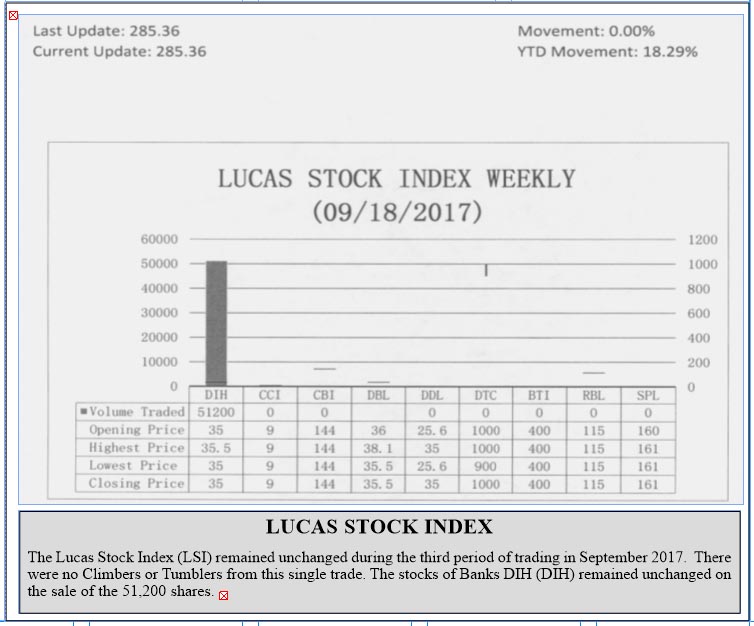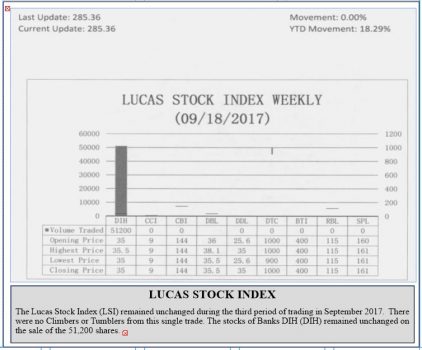Extreme damage
The extreme damage and swath of devastation that have occurred over the past weeks have left many wondering as to what is really happening with global warming and climate change. It is probably the first time in a while that there has been a chain of catastrophic hurricane events in the Latin American and Carib-bean Region in such a short time span. Some conclude that global warming is to be blame; the religious  folk conclude that these disasters are a sign of the end times as prophesied in the Book of Revelations. Whichever it is does not matter, since people are dealing with decisions of survival. Within a matter of weeks, there have been two ‘monster’ storms ‒ Hurricane Irma and Hurricane Maria ‒ that ripped through several Caribbean islands, leaving many of the once lush islands almost brown and barren. Also, not forgetting Hurricane Harvey, the first to begin this month’s tale of disaster and the two earthquakes that rocked Mexico, resulting in numerous deaths and much devastation to that country. The economic and environmental impact of these hurricanes on the small Caribbean islands is far reaching, with the devastation estimated to be in the billions of dollars.
folk conclude that these disasters are a sign of the end times as prophesied in the Book of Revelations. Whichever it is does not matter, since people are dealing with decisions of survival. Within a matter of weeks, there have been two ‘monster’ storms ‒ Hurricane Irma and Hurricane Maria ‒ that ripped through several Caribbean islands, leaving many of the once lush islands almost brown and barren. Also, not forgetting Hurricane Harvey, the first to begin this month’s tale of disaster and the two earthquakes that rocked Mexico, resulting in numerous deaths and much devastation to that country. The economic and environmental impact of these hurricanes on the small Caribbean islands is far reaching, with the devastation estimated to be in the billions of dollars.
These islands, though with a comparatively higher GDP than that of Guyana, find themselves incapacitated by the destructive power of the hurricane. For some of these countries, managing day-to-day life was already challenging. Now to rebuild and regain growth becomes even more difficult. Guyana has offered to help its Caricom partners and has committed assistance to these islands. But, what if other strategies could be utilized to assist in disaster relief efforts? Guyana’s response like those of others remains a short-term solution to events that will continue to occur overtime. The short-term responses should be coupled with longer term strategies to cope with disastrous hurricanes. This week’s article seeks to explore what else might be possible beyond the short-term remedies for dealing with disaster.
An unfortunate mess
The scale of the economic destruction from Irma and Maria is phenomenal. According to Bloomberg, the preliminary damage cost is approximately $30 billion for the Caribbean and Cuba after Hurricane Irma. Hurricane Maria’s estimates will probably be greater. Roadways and rivers are indistinguishable. Buildings have been completely flattened and destroyed; a total unfortunate mess. Hurricane Irma ravaged the Caribbean islands with sustained winds of 185 mph, as a Category five storm, destroying the islands that are home to an estimated 1.2 million people ‒ Barbuda, the British Virgin Islands, St Martin/St Maarten, the US Virgin Islands, and the Turks and Caicos, the islands that were hit the hardest. Irma’s death toll rests at 44 people. Barbuda is now completely uninhabitable. For the first time in 300 years, no one is living on the island reported CNN.
Hurricane Maria has followed a similar path to Irma causing “widespread devastation” in Dominica and later unleashing its fury on Puerto Rico and the Dominican Republic. In a Facebook post earlier last week, Prime Minister of Dominica, Roosevelt Skerrit said, “My roof is gone. I am at the complete mercy of the hurricane. House is flooding.” The Prime Minister was brought to tears during his first live interview on Thursday after the hurricane hit the island, as he spoke of the status of the country in the wake of destructive Maria. Puerto Rico has projected facing months without power. It has lost 95 per cent of its cellphone infrastructure and a dam is threatening to break open with untold consequences. The territory is in total ruins and is pessimistic about a speedy recovery. Hurricane Maria while still making her mark with force has already left a trail of death (26 deaths so far; 15 in Dominica, 9 in Puerto Rico and 2 in Guadeloupe) and destruction in Dominica, Guadeloupe, Dominican Republic, Puerto Rico, and was headed to the Turks & Caicos.
Before and after images from NASA satellites show a grim image of the physical and economic damage caused by Hurricane Irma. Islands that were normally covered in lush vegetation now appear muddy and barren. The hurricane’s 185 mph winds likely ripped away the natural vegetation, leaving bare land behind according to NASA. Maximum sustained winds of 185 miles per hour stripped trees bare in the Virgin Islands. Barbuda is now a dark shade of brown, contrasting with nearby Antigua, which remains fairly green—the island escaped the brutal storm.
The numbers behind the devastation
Farm lands have been destroyed, and the economies of these small islands are predominantly dependent on agriculture and tourism. One wonders about the tourism industry. Tourism is the bread and butter of these economies accounting for well in excess of 50 per cent of their GDP. And with farm lands and crops ruined, the loss of GDP is even greater. Islands like Antigua and Barbuda and St Kitts and Nevis are among the world’s most heavily indebted countries and would find it difficult to easily detach that millstone from around their necks. The other hard-hit islands like the French territories, the BVIs, Anguilla, and the US Virgin Islands to mention a few, are territories of larger and richer nations like the US, France, the UK for example, that are able to help their territories rebuild. For islands like Antigua and Barbuda and Dominica, it’s basically self-help and dependence on Caricom and the international community. There is no longer a godfather. For Antigua and Barbuda, rebuilding will be harder, slower and longer than in the case of other territories with so many people displaced and homeless. The damage and cost of recovery is extremely significant for these countries who do not have godfathers.
Impact on the environment and the economy
Normally, the economic policy choices for these islands would involve seeking to expand trade in goods and services, particularly in agricultural products and tourism. They also seek to increase foreign earnings. It also includes building and protecting the infrastructure. The devastation removes those as immediate policy choices since there are more pressing matters of life and limb. Emergencies produce a different kind of economics. It is one that usually involves no market exchange. The typical response as noted from the Caribbean Disaster Emergency Management Agency (CDEMA) is to protect and help people. Activities include rescuing people, clearing dangerous debris from public thoroughfares, as well as restoring electricity and other public infrastructure like bridges, ports and airports that might have been damaged. It also includes providing shelter, and meeting medical and food needs where they arise. Rebuilding requires capital investment which takes time to acquire. Consequently, money which could have been used to expand output and incomes has to be diverted to short-term disaster management. Further, it is the relationship to global warming and climate change that gives additional significance to the events of the past week. No one knows with certainty how strong the nexus between the ferocious hurricanes and climate change is. But, it cannot be discounted since-scientists have proven that human activities are linked to global warming which in turn can amplify the impact of natural disasters. As the air warms, some of the heat is absorbed by the ocean, which in turn raises the temperature of the sea’s upper layers. The tropical storm, feeding off this unusual warmth, is able to progress from a tropical depression to a category-four hurricane in roughly 48 hours. Climate change is linked to the intensity and worsened effects of these recent disasters.
As the saying goes, it is better to be safe than sorry. Caribbean countries need to intensify their efforts at reaching the goals of sustainable development. Caricom must encourage with greater vigour the use of more sustainable agricultural practices and sustainable production and consumption patterns in the region. It must insist upon greater consumption of foods produced in the region and encourage agricultural practices that lead to greater food security with a lower carbon footprint than is currently the case. In other words, countries in the Caribbean need to take greater control over their agricultural activities to help mitigate the effects of global warming and climate activities.
Disaster relief strategy
Since the Region is known to be hurricane-prone, one must consider the development of strategies to cope with the longer-term effects of hurricane disaster. This includes the meeting of long-term demands that arise to enable territories in the region to stabilize prices and make economic recovery easier. The region needs to look at long-term food storage arrangements that can address both short-term and long-term needs. Guyana could consider establishing a storage facility where certain food products could be stored to help with both short-term and long-term adjustments to disaster. It should also be accompanied with appropriate logistic and infrastructure for meaningful response to a problem. Strategically located, these centres would be in a position to distribute supplies promptly and easily.
Our hearts go out to all the victims of these recent disasters.






